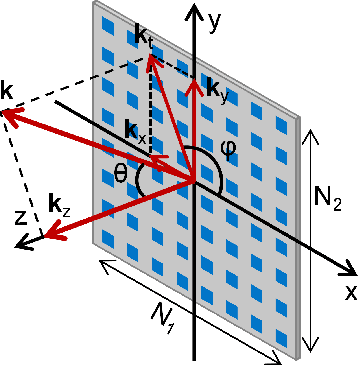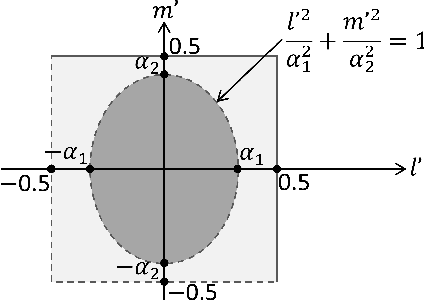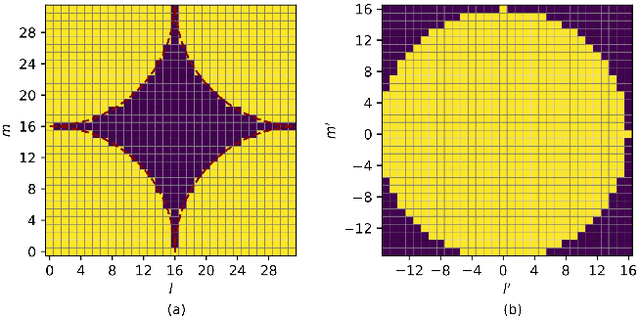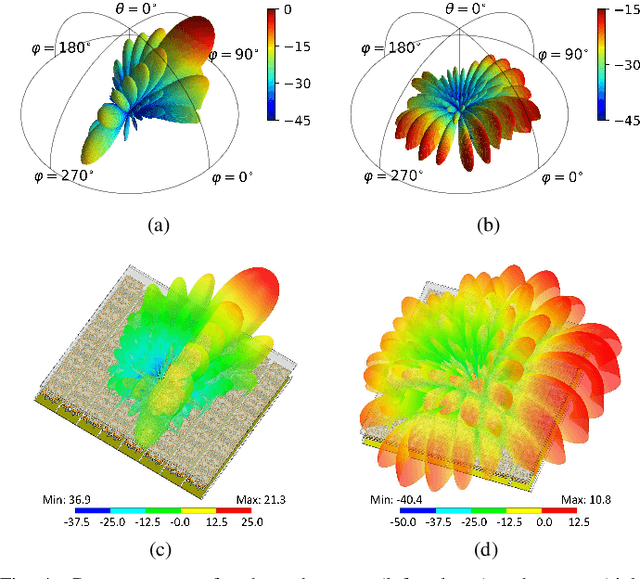Yijian Chen
Joint Size and Placement Optimization for IRS-Aided Communications with Active and Passive Elements
Feb 24, 2025



Abstract:Different types of intelligent reflecting surfaces (IRS) are exploited for assisting wireless communications. The joint use of passive IRS (PIRS) and active IRS (AIRS) emerges as a promising solution owing to their complementary advantages. They can be integrated into a single hybrid active-passive IRS (HIRS) or deployed in a distributed manner, which poses challenges in determining the IRS element allocation and placement for rate maximization. In this paper, we investigate the capacity of an IRS-aided wireless communication system with both active and passive elements. Specifically, we consider three deployment schemes: 1) base station (BS)-HIRS-user (BHU); 2) BS-AIRS-PIRS-user (BAPU); 3) BS-PIRS-AIRS-user (BPAU). Under the line-of-sight channel model, we formulate a rate maximization problem via a joint optimization of the IRS element allocation and placement. We first derive the optimized number of active and passive elements for BHU, BAPU, and BPAU schemes, respectively. Then, low-complexity HIRS/AIRS placement strategies are provided. To obtain more insights, we characterize the system capacity scaling orders for the three schemes with respect to the large total number of IRS elements, amplification power budget, and BS transmit power. Finally, simulation results are presented to validate our theoretical findings and show the performance difference among the BHU, BAPU, and BPAU schemes with the proposed joint design under various system setups.
Spatial Bandwidth of Bilateral Near-Field Channels for Linear Large-Scale Antenna Array System
Dec 06, 2024



Abstract:This paper analyzes the spatial bandwidth of line-of-sight (LoS) channels in massive MIMO systems. For the linear large-scale antenna arrays (LSAA) of transceivers placed in random locations in 3D space, a simple but accurate closed-form expression is derived to characterize the spatial bandwidth. Subsequent analysis of the LSAA's spatial bandwidth properties is also provided, leading to the formulation of an approximate expression for the effective degrees of freedom (EDoF) of bilateral near-field channels. Interestingly, as proved in this work, when the transmit and receive arrays are coplanar, with the receive array positioned perpendicular to the axis joining the centroids of the transmit and receive arrays, the EDoF of the LoS channel is found to be approximately maximized.
Revealing the evanescent components in Kronecker-product based codebooks: insights and implications
Jul 09, 2024



Abstract:The orthogonal bases of discrete Fourier transform (DFT) has been recognized as the standard spatial-domain bases for Type I, Type II and enhanced Type II codewords by the 3rd Generation Partnership Project (3GPP). For uniform planar arrays, these spatial-domain bases are derived as the Kronecker product of one-dimensional DFT bases. Theoretically, each spatial basis corresponds to a beam directed towards a specific angle of departure and the set of bases represent the orthogonal beams that cover the front hemisphere of an array. While the Kronecker-product based precoding scheme facilitates the concise indexing of a codeword in the codebooks through precoding matrix indicators (PMIs) in channel state information feedback, it introduces redundant spatial beams characterized by high spatial-frequency components. This paper investigates the presence of codewords representing high spatial-frequency components within the Kronecker-product based codebooks. Through theoretical analysis and simulations, we confirm the redundancy of these codewords in MIMO communications, advocating for their removal from the codebooks to enhance system performance. Several topics relevant to the high spatial components are also involved in the discussion. Practical suggestions regarding future standard design are provided based on our theoretical analysis and simulation results.
Spatial Non-Stationary Dual-Wideband Channel Estimation for XL-MIMO Systems
Jul 08, 2024Abstract:In this paper, we investigate the channel estimation problem for extremely large-scale multi-input and multi-output (XL-MIMO) systems, considering the spherical wavefront effect, spatially non-stationary (SnS) property, and dual-wideband effects. To accurately characterize the XL-MIMO channel, we first derive a novel spatial-and-frequency-domain channel model for XL-MIMO systems and carefully examine the channel characteristics in the angular-and-delay domain. Based on the obtained channel representation, we formulate XL-MIMO channel estimation as a Bayesian inference problem. To fully exploit the clustered sparsity of angular-and-delay channels and capture the inter-antenna and inter-subcarrier correlations, a Markov random field (MRF)-based hierarchical prior model is adopted. Meanwhile, to facilitate efficient channel reconstruction, we propose a sparse Bayesian learning (SBL) algorithm based on approximate message passing (AMP) with a unitary transformation. Tailored to the MRF-based hierarchical prior model, the message passing equations are reformulated using structured variational inference, belief propagation, and mean-field rules. Finally, simulation results validate the convergence and superiority of the proposed algorithm over existing methods.
Patterned Beam Training: A Novel Low-Complexity and Low-Overhead Scheme for ELAA
Jun 01, 2024


Abstract:Extremely large antenna arrays (ELAAs) can provide higher spectral efficiency. However, the use of narrower beams for data transmission significantly increases the overhead associated with beam training. In this letter, we propose a novel patterned beam training (PBT) scheme characterized by its low overhead and complexity. This scheme requires only a single linear operation by both the base station and the user equipment to determine the optimal beam, reducing the training overhead to half or even less compared to traditional exhaustive search methods. Furthermore, We discuss the pattern design principles in detail and provide specific forms. Simulation results demonstrate that the proposed scheme outperforms the compared methods in terms of beam alignment accuracy and achieves a balance between signal-to-noise ratio (SNR) conditions and training overhead, making it a promising alternative.
Fast Beam Training and Performance Analysis for Extremely Large Aperture Array
Apr 28, 2024Abstract:Extremely large aperture array (ELAA) can significantly enhance beamforming gain and spectral efficiency. Unfortunately, the use of narrower beams for data transmission results in a substantial increase in the cost of beam training. In this paper, we study a high-efficiency and low-overhead scheme named hash beam training. Specifically, two improved hash codebook design methods, random and fixed, are proposed. Moreover, we analyze beam alignment performance. Since the derived beam alignment success probability is a complex function, we also propose a heuristic metric to evaluate the impact of codebook parameter on performance. Finally, simulation results validate the theoretical analysis, indicating that the proposed beam training scheme can achieve fast beam alignment with lower overhead and higher accuracy.
Spatially Non-Stationary XL-MIMO Channel Estimation: A Three-Layer Generalized Approximate Message Passing Method
Mar 05, 2024



Abstract:In this paper, channel estimation problem for extremely large-scale multi-input multi-output (XL-MIMO) systems is investigated with the considerations of the spherical wavefront effect and the spatially non-stationary (SnS) property. Due to the diversities of SnS characteristics among different propagation paths, the concurrent channel estimation of multiple paths becomes intractable. To address this challenge, we propose a two-phase channel estimation scheme. In the first phase, the angles of departure (AoDs) on the user side are estimated, and a carefully designed pilot transmission scheme enables the decomposition of the received signal from different paths. In the second phase, the subchannel estimation corresponding to different paths is formulated as a three-layer Bayesian inference problem. Specifically, the first layer captures block sparsity in the angular domain, the second layer promotes SnS property in the antenna domain, and the third layer decouples the subchannels from the observed signals. To efficiently facilitate Bayesian inference, we propose a novel three-layer generalized approximate message passing (TL-GAMP) algorithm based on structured variational massage passing and belief propagation rules. Simulation results validate the convergence and effectiveness of the proposed algorithm, showcasing its robustness to different channel scenarios.
Low-Complexity Channel Estimation for Extremely Large-Scale MIMO in Near Field
Dec 07, 2023



Abstract:The extremely large-scale massive multiple-input multiple-output (XL-MIMO) has the potential to achieve boosted spectral efficiency and refined spatial resolution for future wireless networks. However, channel estimation for XL-MIMO is challenging since the large number of antennas results in high computational complexity with the near-field effect. In this letter, we propose a low-complexity sequential angle-distance channel estimation (SADCE) method for near-field XL-MIMO systems equipped with uniformly planar arrays (UPA). Specifically, we first successfully decouple the angle and distance parameters, which allows us to devise a two-dimensional discrete Fourier transform (2D-DFT) method for angle parameters estimation. Then, a low-complexity distance estimation method is proposed with a closed-form solution. Compared with existing methods, the proposed method achieves significant performance gain with noticeably reduced computational complexity.Numerical results verify the superiority of the proposed near-field channel estimation algorithm.
Joint Visibility Region and Channel Estimation for Extremely Large-scale MIMO Systems
Nov 16, 2023



Abstract:In this work, we investigate the channel estimation (CE) problem for extremely large-scale multiple-input-multiple-output (XL-MIMO) systems, considering both the spherical wavefront effect and spatial non-stationarity (SnS). Unlike existing non-stationary CE methods that rely on the statistical characteristics of channels in the spatial or temporal domain, our approach seeks to leverage sparsity in both the spatial and wavenumber domains simultaneously to achieve an accurate estimation.To this end, we introduce a two-stage visibility region (VR) detection and CE framework. Specifically, in the first stage, the belief regarding the visibility of antennas is obtained through a structured message passing (MP) scheme, which fully exploits the block sparse structure of the antenna-domain channel. In the second stage, using the obtained VR information and wavenumber-domain sparsity, we accurately estimate the SnS channel employing the belief-based orthogonal matching pursuit (BB-OMP) method. Simulations demonstrate that the proposed algorithms lead to a significant enhancement in VR detection and CE accuracy, especially in low signal-to-noise ratio (SNR) scenarios.
How Practical Phase-shift Errors Affect Beamforming of Reconfigurable Intelligent Surface?
Apr 13, 2023Abstract:Reconfigurable intelligent surface (RIS) is a new technique that is able to manipulate the wireless environment smartly and has been exploited for assisting the wireless communications, especially at high frequency band. However, it suffers from hardware impairments (HWIs) in practical designs, which inevitably degrades its performance and thus limits its full potential. To address this practical issue, we first propose a new RIS reflection model involving phase-shift errors, which is then verified by the measurement results from field trials. With this beamforming model, various phase-shift errors caused by different HWIs can be analyzed. The phase-shift errors are classified into three categories: (1) globally independent and identically distributed errors, (2) grouped independent and identically distributed errors and (3) grouped fixed errors. The impact of typical HWIs, including frequency mismatch, PIN diode failures and panel deformation, on RIS beamforming ability are studied with the theoretical model and are compared with numerical results. The impact of frequency mismatch are discussed separately for narrow-band and wide-band beamforming. Finally, useful insights and guidelines on the RIS design and its deployment are highlighted for practical wireless systems.
 Add to Chrome
Add to Chrome Add to Firefox
Add to Firefox Add to Edge
Add to Edge